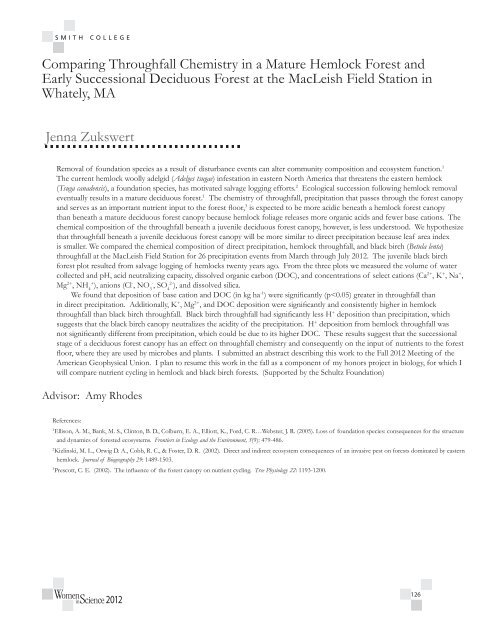Brugia Malayi - Clark Science Center - Smith College
Brugia Malayi - Clark Science Center - Smith College
Brugia Malayi - Clark Science Center - Smith College
You also want an ePaper? Increase the reach of your titles
YUMPU automatically turns print PDFs into web optimized ePapers that Google loves.
Comparing Throughfall Chemistry in a Mature Hemlock Forest and<br />
Early Successional Deciduous Forest at the MacLeish Field Station in<br />
Whately, MA<br />
Jenna Zukswert<br />
Removal of foundation species as a result of disturbance events can alter community composition and ecosystem function. 1<br />
The current hemlock woolly adelgid (Adelges tsugae) infestation in eastern North America that threatens the eastern hemlock<br />
(Tsuga canadensis), a foundation species, has motivated salvage logging efforts. 2 Ecological succession following hemlock removal<br />
eventually results in a mature deciduous forest. 1 The chemistry of throughfall, precipitation that passes through the forest canopy<br />
and serves as an important nutrient input to the forest floor, 3 is expected to be more acidic beneath a hemlock forest canopy<br />
than beneath a mature deciduous forest canopy because hemlock foliage releases more organic acids and fewer base cations. The<br />
chemical composition of the throughfall beneath a juvenile deciduous forest canopy, however, is less understood. We hypothesize<br />
that throughfall beneath a juvenile deciduous forest canopy will be more similar to direct precipitation because leaf area index<br />
is smaller. We compared the chemical composition of direct precipitation, hemlock throughfall, and black birch (Betula lenta)<br />
throughfall at the MacLeish Field Station for 26 precipitation events from March through July 2012. The juvenile black birch<br />
forest plot resulted from salvage logging of hemlocks twenty years ago. From the three plots we measured the volume of water<br />
collected and pH, acid neutralizing capacity, dissolved organic carbon (DOC), and concentrations of select cations (Ca 2+ , K + , Na + ,<br />
Mg 2+ , NH 4+<br />
), anions (Cl - , NO 3-<br />
, SO 4<br />
2-<br />
), and dissolved silica.<br />
We found that deposition of base cation and DOC (in kg ha -1 ) were significantly (p

















